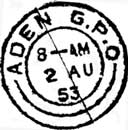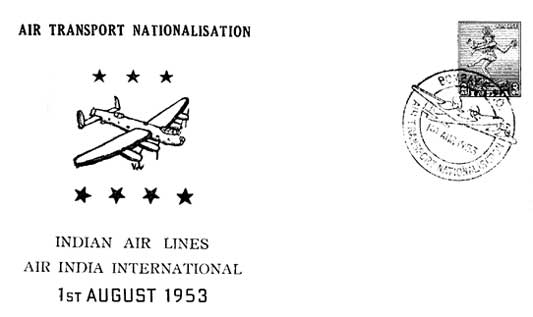Nationalization of Air Transport - 1st August 1953
Before dealing with Nationalization of Air Transport, we must take a look in the past to know how scheduled commercial air transport came to India. It all happened in 1929 - 30, when Imperial Airways of England was extending its Air Routes to and
 |
across Indian Sub-continent. The Government of India had, of necessity, to establish in 1930 the first , although short lived, Indian State Air Service as a link between Karachi & Calcutta. This venture was abandoned in 1931 due to heavy operating losses. The Imperial airways operated air mail services between Karachi and Delhi. Neither Indian Capital nor the Indian personnel or technician was allowed to participate in the air mail services in between Karachi and Delhi by Imperial Airways. Therefore, this contract was opposed by the public through the Press. The result came immediately. The Government cancelled the contract of Imperial airways and entrusted the task to Delhi Flying Club. But mounting financial losses drove the Delhi Flying Club out of business. Then came Tata Sons Ltd., who claimed to be the first Indian Commercial airlines manned and managed by Indians with indigenous capital and labour. It started its operation from 15th October 1932, in between Karachi and Madras via Ahmedabad, Bombay and Bellary. Slowly many Indian Air lines cropped up. The Government of India had passed the following Rules and Acts to control Country’s Air Transport Industries.
During 1945, the Government of India announced Industrial Air
Conveyance Policy as follows:
“The Policy of the Government of India is to permit the development and
operation of air transport services, internal and external by a limited number
of sound and reliable private commercial organizations, with their own capital.
The operation of air transport services would be subject to licence, granted
by the Government. Without such a licence, no air transport services can operate.
The grant of State assistance in specific cases will be entirely at the discretion
of the Government and on conditions to be laid down in each case. In specific
cases, the Government should take a financial interest in the companies operating
air services and appoint a Director on Board. The Government should not, however,
take a controlling share in each cases”.
On 1st July 1946, the following Air Services were operating
in India.
| 1. Indian National Airways Ltd. | 2. Tata Airlines Ltd.,(Tata Airlines Ltd) |
| 3. Air Services of India Ltd., | 4. Deccan Airways Ltd. |
By 30th November 1948, the following Air Companies were operating in India.
| 1. Indian National Airways Ltd. | 2. Air India Ltd., (Tata Airlines Ltd) | 3. Air Services of India Ltd. |
| 4. Deccan Airways Ltd. | 5. Airways Indian Ltd. | 6. Ambica Airlines Ltd. |
| 7. Bharat Airlines Ltd. | 8. Dalmia Jain Airways Ltd. | 9. Indian Overseas Airlines Ltd. |
| 10. Jupiter Airways Ltd. |
Time to time many policies were framed to help the Airways Companies but
they were not sufficient for them to survive. Then the Ministry of Communication,
Government of India appointed the air Transport Inquiry Committee to scrutinise
all the problems affecting the Indian Airtransport Industry and to recommand
measures to stablized its economic position and ensure its future development.
A tentative decision to nationalize air industry was taken but the Government
was most reluctant to implement it. Actually, the Government was waiting
for an opportune time to enforce her decision.
The relentless attack made by the opposition compelled the National Government
to constitute a Select Committee from among the Members of Parliament. The
Committee was composed of 36 members, who recomended two separate Corporation
after Nationalization.
The Air Corporation Bill was legislated into an Act which brought forth
two nationalized Air Corporation, viz Indian airlines Corporation (for operation
of internal air services in the country and adjacent countries like Burma,
Ceylon and Pakistan) and the Air India International for operation of long
distance International Services, was constituted on 15th June 1953 and took
over the undertakings of the nine air transport companies with effect from
1st August 1953. The Indian air transport system was composed of the following
airlines:
| 1. Air India Ltd. | 2. Air Services of India Ltd. | 3. Airways India |
| 4. Bharat Airways | 5. Deccan Airways | 6. Himalayan Aviation Ltd. |
| 7. Indian National Airways | 8. Kalinga Airlines | 9.Air India International Ltd. |
A Special Cover with a Commemorative Cancellation was issued on the occassion
from all Philatelic Bureaux. The cancellation is found in black and violet
inks.
 |
 |
|
The Delivery Mark of ADEN GPO shows that it was delivered at 8 - AM on next day.
|
|
|
The Special Cover with the Commemorative Cancellation
of “AIR TRANSPORT NATIONALIZATION” appears to be a First
Flight Cover from India to Aden, after Nationalization. 10 annas Air
Mail postage was paid.
It was mailed from Bombay GPO on 1st August 1953. |
|
|
|
|
A privately printed Special Cover with 2 annas postage
stamp was defaced by Bombay GPO with the Commemorative Cancellation
of “AIR TRANSPORT NATIONALIZATION”. INDIAN AIR LINES / AIR
INDIA INTERNATIONAL / 1st AUGUST 1953.
|
Readers
are requested to send their query/comments to Mr. Ashok Kumar Bayanwala,96,
Swastik Society, Navarangpura, AHMEDABAD-380009, INDIA or email to
Prashant
H. Pandya
